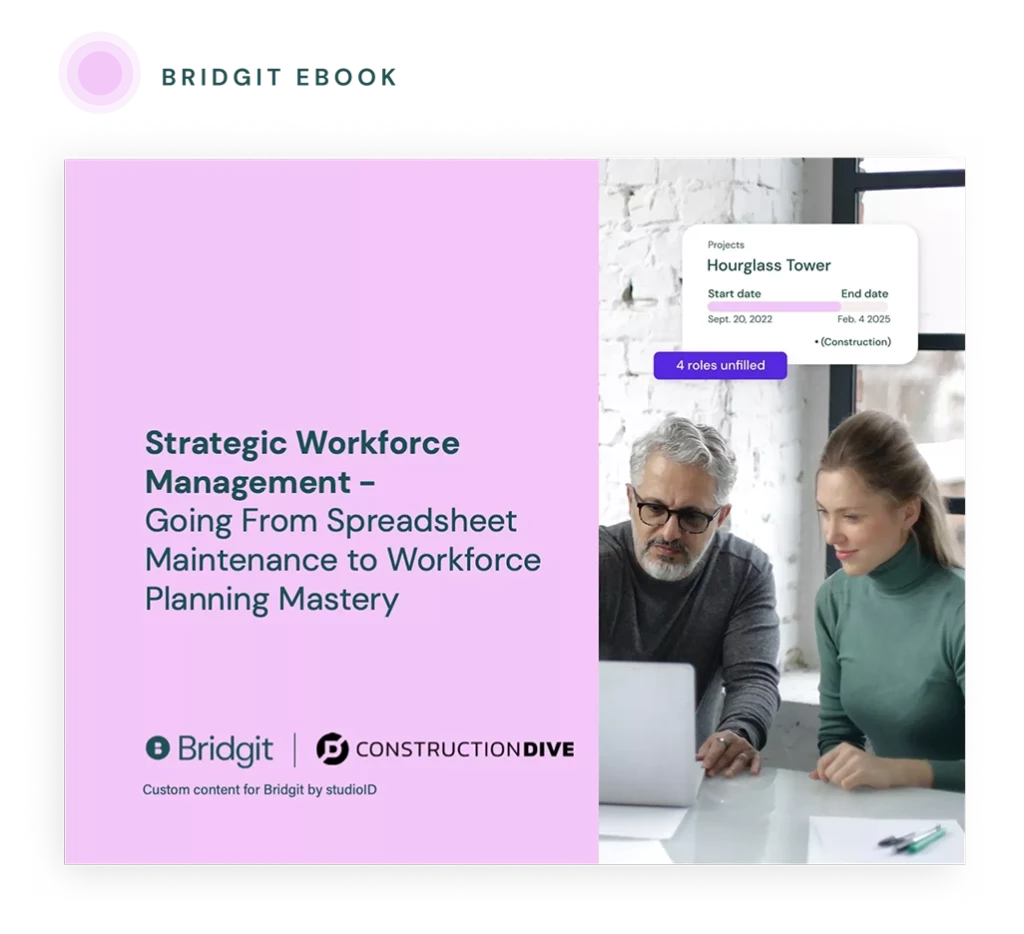It’s no secret that the construction industry is facing a labor shortage. The pandemic has exasperated the situation but labor shortages are nothing new for the industry. Since the homebuilding boom of the early 2000s, a lack of labor has become the norm. With an aging pool of skilled workers and a huge demand for labor, the shortage has reached a new level with roughly 25% more unfilled construction positions than hires.
Table of Contents
Construction companies must be more strategic than ever before in order to maximize their current workforces and predict labor capacity for the future. It’s a difficult job because of inefficient manual processes that silo data, making it hard to collaborate. In a survey done by Bridgit, 70% of the GCs said they are planning their workforce less than two months in advance. Additionally, 46% said that they don’t have adequate time to hire when the project needs it.
These statistics point to a reactive business model that leaves contractors rushing to fill gaps, project delays due to lack of labor, and employees that may not be a good fit for the company.
Being proactive and having insight into your workforce months or years in advance can mitigate these problems, and prepare contractors to handle constraints as they arise.
Here are three ways strategically planning your workforce can combat labor shortages in 2023.
1. Recruitment
On the surface, the way to combat a labor shortage is to have your recruitment strategy in order before a project comes up. The best way to do this is to have systems in place that can provide insight into when people are coming off jobs and when jobs are starting.
If this is visible over longer stretches of time, it’s easy to see who in your company is being underutilized. It also gives your HR team enough leeway to put together a recruitment plan – the job description, publishing the job, working with recruiters and job boards, conducting interviews, and screening applicants.
Effective recruitment mitigates the steep costs of replacing an employee that wasn’t a good fit. According to Busy Busy, the turnover cost for laborers making $30,000 or less can be up to 16% of their annual salary. For employees earning about $50,000, the turnover cost is 20% of their salary and for specialized jobs like superintendents, engineers, and project managers turnover costs can be as high as 213% – that’s a cost of $213,000 on a $100,000 salary.
Planning for recruitment early will help deal with delays around labor shortages and allow time to recruit the right people – an essential part of combatting the high costs of employee turnover.

Looking to be more strategic with your people?
We partnered with Construction Dive to outline the steps any contractor can take to be more strategic with their workforce management.
2. Don’t just plan projects, plan your pursuits.
A mistake many contractors make is not planning for pursuits that aren’t awarded yet. In the same Bridgit survey, 86% of contractors said they’ve bid on projects only to find they don’t have the proper workforce to complete the job. This alarming statistic points to the difficulty of predicting and planning labor. Filling this gap by planning pursuits can immediately alleviate labor shortages that seem to occur by surprise.
Another benefit to planning pursuits is an improved bid-hit ratio. According to 1st Source Bank, the bid-hit ratio is “the winning rate at which you successfully bid or propose on construction projects.” For example, a 5:1 bid-hit ratio means for every five projects you bid on, one is awarded.
Having a lower ratio is ideal, but varies from company to company. Planning labor for pursuits can improve this ratio because contractors understand their capacity to take on new jobs. As they find an ideal capacity, winning bids happen more often and the opportunity cost of losing bids is curtailed. Understanding where and how work is won can help contractors grow sustainably while mitigating labor shortages.
3. Filling skills gaps
Finally, it’s important to understand that labor shortages don’t necessarily mean that there is a lack of people to complete a job. It could mean that the right kind of labor or skill is missing. According to Associated Builders and Contractors (ABC) in 2022, entry-level laborers increased by 72.8%, but the total number of laborers only increased 25%. This indicates a sizable skills gap. The solution to this should include the development of the workforce already in place.
Contractors need to have systems where they can track experience, certifications, career trajectory, and education for current employees. With siloed systems in place and limited transparency into data, workers aren’t developing as they should because they’re being used to fill gaps in a reactive way.
With more insight into the development of the workforce – not just where people need to be at any given time – managers are able to put workers in a situation where they’re expanding their skill set and futureproofing their workforce.
For example, a contractor may have a mason who’s expressed interest in becoming a superintendent. By tracking their skills and helping them get the necessary certifications, the mason could fill a superintendent gap that arises as a new project begins.
Doing this effectively requires contractors to zoom out of the reactive daily management of projects and begin looking at their workforce long-term. A common-data strategy, in which the whole company can access insights on projects and people can help. With the current tools at their disposal, it’s difficult to do this because they aren’t designed to provide that kind of dynamic depth.
Tools like Bridgit Bench are designed to help general contractors develop this common data strategy for their workforce by collecting people and project data in one place. In Bridgit Bench, changes are updated in real-time making it easier to collaborate and stay informed about workforce needs.


